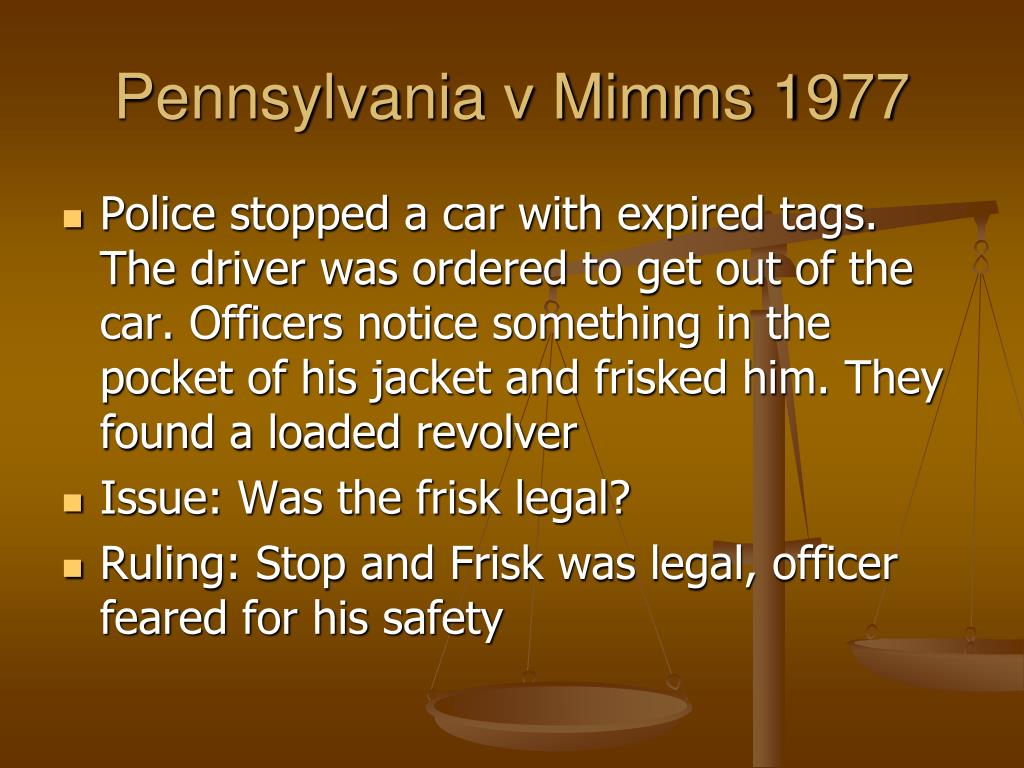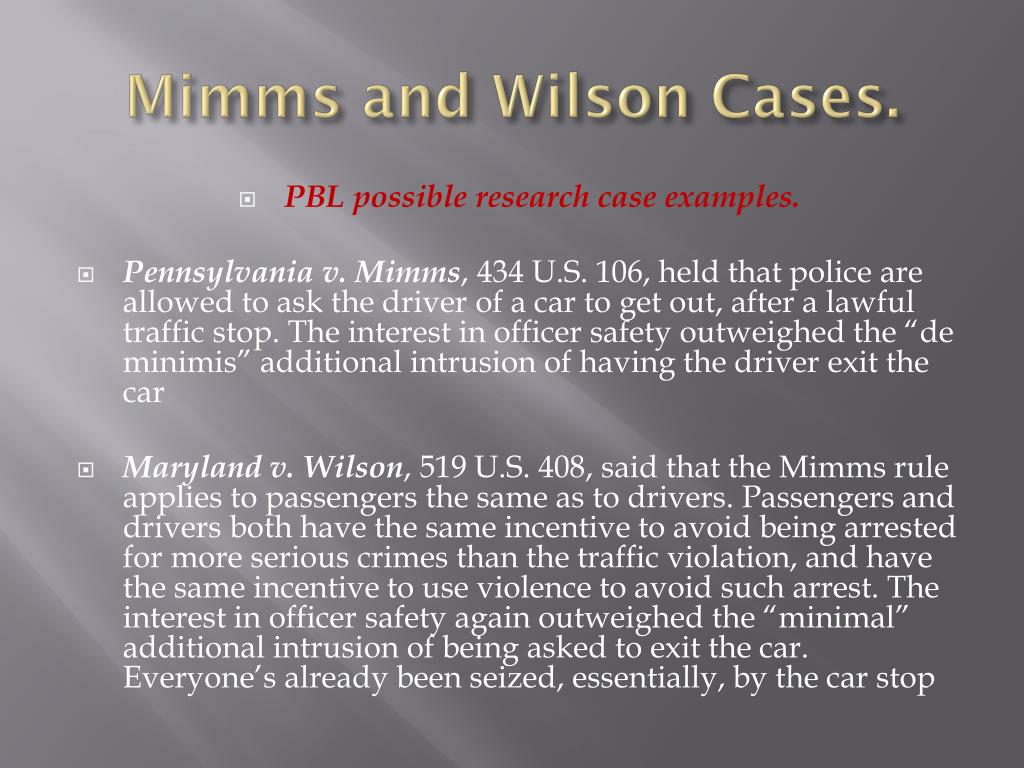Mimms V. Pennsylvania: Supreme Court Ruling & Traffic Stop Frisks
Does the Fourth Amendment of the United States Constitution allow law enforcement officers to order a driver out of a vehicle during a routine traffic stop, even in the absence of any suspicion of criminal activity beyond the initial infraction? The Supreme Court's decision in Pennsylvania v. Mimms, a landmark case decided in 1977, provides a definitive answer, shaping the landscape of traffic stop procedures and the delicate balance between officer safety and individual rights.
The genesis of this pivotal case lay in a seemingly ordinary traffic stop. On an unspecified date, in the state of Pennsylvania, a police officer observed a vehicle being driven with an expired license plate. The officer, acting within his lawful authority, initiated a traffic stop. The driver of the vehicle was Harry Mimms. Upon stopping Mimms, the officer, following standard protocol, approached the vehicle. Before asking for Mimms' license and registration, the officer instructed Mimms to exit the vehicle. As Mimms complied with this request, the officer noticed a significant bulge under Mimms' jacket. Fearing for his safety, the officer conducted a pat-down, or frisk, of Mimms. This search revealed a loaded revolver concealed on Mimms' person. Subsequently, Mimms was arrested and charged with carrying a concealed deadly weapon and unlawfully carrying a firearm without a license. The case, which would eventually reach the highest court in the land, centered on the legality of the officer's actions during this traffic stop, specifically focusing on the order to exit the vehicle and the subsequent frisk.
| Category | Details |
|---|---|
| Subject of the Case | Harry Mimms |
| Date of Birth (Approximate) | Information Not Available (Based on case timeline) |
| Residence (At the Time) | Pennsylvania, USA |
| Known For | Being the respondent in the landmark Supreme Court case, Pennsylvania v. Mimms, which has significantly shaped the law regarding traffic stops and the Fourth Amendment. |
| Career (Pre-Arrest) | Information Not Available |
| Education | Information Not Available |
| Legal Issues Involved | Fourth Amendment rights, unlawful search and seizure, officer safety during traffic stops, and the balance between individual liberties and law enforcement procedures. |
| Key Events | Traffic stop for expired license plate, order to exit the vehicle, discovery of a concealed weapon, arrest, conviction overturned by the Pennsylvania Supreme Court, and ultimately, the Supreme Court's decision. |
| Impact of Case | Established the precedent that officers can order drivers out of vehicles during a traffic stop, which has had a lasting impact on law enforcement procedures nationwide, and on the interpretation of Fourth Amendment rights during vehicle stops. |
| Further Reading | Justia - Pennsylvania v. Mimms, 434 U.S. 106 (1977) |
The legal journey of the Mimms case wound its way through the judicial system. Initially, Mimms was convicted of the weapons charges. However, the Pennsylvania Supreme Court, on appeal, overturned the conviction. The state's highest court held that the officer's request for Mimms to exit the vehicle constituted an unlawful seizure, violating the Fourth Amendment of the United States Constitution. This ruling set the stage for a confrontation with the Supreme Court, as the Commonwealth sought review of the Pennsylvania Supreme Court's decision. This decision, handed down on December 5, 1977, became a cornerstone in the jurisprudence of the Fourth Amendment.
- Sammi Sweetheart Christian Biscardi Split What Happened
- Pasco County Arrests Jail Info Find Mugshots Bookings
The crux of the legal debate centered on the constitutionality of the officer's actions. Did the officer's order for Mimms to exit the vehicle, and the subsequent frisk, violate Mimms' Fourth Amendment rights, which protects individuals from unreasonable searches and seizures? The Supreme Court, in its unanimous decision, directly addressed this question. The court acknowledged that the initial stop of Mimms' vehicle for an expired license plate was lawful. However, the central issue was whether the officer's actions following the stop were justified.
The Supreme Court's reasoning was grounded in the principle of officer safety. The Court recognized the inherent dangers faced by law enforcement officers during traffic stops. They held that the government's interest in protecting officers from potential harm outweighed the relatively minor intrusion on the driver's Fourth Amendment rights when asked to step out of the vehicle. The Court cited the need for officers to maintain control of the situation and to minimize the risks they face. In the Court's view, the order to exit the vehicle was a reasonable measure designed to enhance officer safety.
The Courts decision emphasized the importance of balancing individual liberties with the practical needs of law enforcement. The court found the intrusion on Mimms' rights to be de minimisminimal. It reasoned that the requirement to exit the vehicle was not a significant infringement. The Court's decision also noted that once Mimms had exited the vehicle, and the officer observed the bulge, the frisk for weapons was reasonable under the circumstances. The existence of the bulge provided the officer with reasonable suspicion to believe that Mimms was armed and dangerous, which is the justification for a "Terry" stop, based on the case of Terry v. Ohio.
- Explore Top Japanese Celebrities Rising Stars Cultural Icons
- Understanding The 5 Ps Of Labor A Comprehensive Guide For You
The Supreme Court reversed the Pennsylvania Supreme Court's decision, upholding Mimms' conviction. The Supreme Court's decision in Pennsylvania v. Mimms, found at 434 U.S. 106 (1977), established a significant precedent. The court clarified the parameters of Fourth Amendment rights during traffic stops and affirmed the authority of law enforcement officers to take reasonable steps to ensure their safety. The decision has had a lasting impact on how traffic stops are conducted nationwide.
The Mimms case is often cited in legal discussions regarding officer safety and the permissible scope of searches during traffic stops. The decision has been extended in subsequent cases, such as Maryland v. Wilson, which allows officers to order passengers out of a lawfully stopped vehicle as well. This expansion of authority continues to spark debate.
This case underscores the complex interplay between individual rights and public safety. The Court attempted to strike a balance, prioritizing the safety of law enforcement officers while acknowledging the constitutional protections afforded to citizens. The legacy of Pennsylvania v. Mimms remains a subject of ongoing discussion in legal circles. It is a key component in understanding the Fourth Amendment.
The dissenting arguments in the case, though not successful in the final decision, emphasized the potential for abuse of the authority granted to officers. The dissenters voiced concerns that the ruling could lead to unnecessary intrusions on individual liberty, particularly in situations where there was no specific reason to suspect criminal activity. While the Court recognized the importance of officer safety, critics argued that the Mimms decision could open the door to arbitrary and potentially discriminatory practices during traffic stops.
The ongoing impact of Pennsylvania v. Mimms is evident in the training and procedures of law enforcement agencies across the United States. Officers are trained to recognize potential threats during traffic stops and to take appropriate safety precautions, including ordering drivers and passengers out of vehicles. The case has also influenced the development of case law related to the Fourth Amendment, particularly in cases involving vehicle searches. The case is a fundamental aspect of any legal education course on constitutional law and criminal procedure.
The court's unanimous decision, emphasizing the government's interest in officer safety, established a clear precedent. Officers could, without specific suspicion, order drivers to exit their vehicles during a traffic stop. This ruling has significantly shaped traffic stop procedures. It highlights the need for a balance between the rights of the individual and the need to ensure the safety of law enforcement officers. The Mimms case has become a cornerstone of legal understanding, providing clarity on the complex relationship between law enforcement and the citizens they serve.
The specific details surrounding the incident, such as the exact location of the traffic stop and the identity of the officers involved (beyond their professional capacity), are not extensively documented in the available legal materials. However, the core legal issues, the court's reasoning, and the ultimate holding are clear and have had a lasting impact on legal practice and public understanding of Fourth Amendment rights. The case serves as a reminder of the ongoing efforts to balance public safety with the protection of individual liberties, a fundamental tenet of the American legal system.
The case's influence extends beyond the courtroom. The decision continues to be debated in legal and academic circles. It is a focal point in discussions on police practices, racial profiling, and the balance between individual rights and public safety. By understanding the nuanced legacy of this case, attorneys, scholars, and the public can gain a deeper appreciation for the ongoing efforts to balance the competing interests inherent in traffic stop situations. The Supreme Court's ruling in Pennsylvania v. Mimms is a reminder of the legal principles that underpin the American justice system.
The case also connects with the broader landscape of civil rights and equal protection. Critics of the Mimms ruling and similar decisions have expressed concerns that the authority granted to officers could be disproportionately applied to minority communities, leading to discriminatory practices. Therefore, discussions of Pennsylvania v. Mimms often intersect with larger conversations about racial bias in law enforcement and the importance of ensuring equal treatment under the law. The principles of the Fourth Amendment, as interpreted in Mimms, continue to shape the interaction between law enforcement and the public, reinforcing the importance of understanding the context.
The principle of "officer safety" is a core rationale in Mimms. It is worth noting that the Court's ruling was grounded in the belief that the risk of harm to officers during traffic stops is significant. This belief has fueled the widespread adoption of safety measures, from the initial order to exit the vehicle to the frisking of individuals. Critics have consistently raised questions about the scope of such measures, and the potential for abuses, which has resulted in continued debate regarding the constitutionality of such practices.
The Supreme Courts decision, handed down on December 5, 1977, set the stage for a shift in law enforcement practices regarding traffic stops. By ruling in favor of the legality of the officer's actions, the Court effectively affirmed the power of law enforcement to take proactive measures to protect their safety. The impact of the case is reflected in how law enforcement agencies across the country conduct traffic stops, the training provided to officers, and the ongoing debate surrounding the balance between officer safety and individual rights.
The core issue in Pennsylvania v. Mimms centered on the Fourth Amendment's protection against unreasonable searches and seizures. The Supreme Court's decision in Mimms has been a critical component in interpreting the boundaries of these rights in the context of traffic stops. By clarifying the boundaries of permissible actions by law enforcement officers during these stops, the Court has greatly shaped the legal framework. The legal arguments presented in the case, as well as the court's final ruling, continue to be essential elements in legal education.
The significance of the Mimms case, lies not just in its immediate impact on the parties involved but in its enduring influence on law enforcement procedures. The case is often cited in discussions about the limits of police power and the protections guaranteed by the Fourth Amendment. It is a focal point for legal scholars and attorneys when considering the balance between the rights of the individual and the necessities of public safety.
- Find Your Ascendant Sign Uncover Your Rising Sign Now
- July 3 Zodiac Unveiling The Cancer Personality Traits

PPT Landmark 4th Amendment Cases Overview PowerPoint Presentation

Pennsylvania V Mimms (1977) informacionpublica.svet.gob.gt

PPT 4 th Amendment PowerPoint Presentation, free download ID 2666224